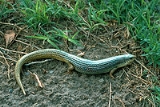
Great Plains Skink
Encyclopedia
The Great Plains Skink is — together with the Broad-headed Skink
— the largest skink
of the genus Eumeces
. It reaches a length of 9 to 13 cm (3.5 to 5 inches) from snout to vent or up to nearly 34 cm (13.5 in) total length (including the tail).
This lizard
is light gray or beige in color; its dorsal scales have black or dark brown edges. The scales on the sides run diagonally. The belly is yellow. Juveniles are black with white sports on the lips and the head and have a blue or bluish tail.
The Great Plains Skink is very common on the Great Plains
, ranging from south-eastern Wyoming
and Nebraska
(and also Fremont County, Iowa
) down to eastern Arizona
, Texas
, and into Mexico
.
This skink lives in open plains habitat
or the eastern foothills
of the Rocky Mountains
, in areas near water, e.g. irrigation ditches. In southeastern Colorado, it occurs in elevation up to about 1900 m (7200 ft); in northern Colorado, only at elevations below about 1400 m (4500 ft).
The mating season of the Great Plains Skink is in April or May. The female lays between 5 and 32 eggs (on the average about 12) in early summer, which she guards until they hatch in late summer.
Broad-headed Skink
The Broad-headed Skink is — together with the Great Plains Skink — the largest of the Eumeces-skinks, growing to a total length of to nearly .-Description:...
— the largest skink
Skink
Skinks are lizards belonging to the family Scincidae. Together with several other lizard families, including Lacertidae , they comprise the superfamily or infraorder Scincomorpha...
of the genus Eumeces
Eumeces
The genus Eumeces skinks comprises four African to Middle-Eastern species.-Systematics:Two taxonomic revisions have been made in the 19th century regarding genus Eumeces. They both resulted in similar results; the genus is paraphyletic and must be sliced up into several different genera...
. It reaches a length of 9 to 13 cm (3.5 to 5 inches) from snout to vent or up to nearly 34 cm (13.5 in) total length (including the tail).
This lizard
Lizard
Lizards are a widespread group of squamate reptiles, with nearly 3800 species, ranging across all continents except Antarctica as well as most oceanic island chains...
is light gray or beige in color; its dorsal scales have black or dark brown edges. The scales on the sides run diagonally. The belly is yellow. Juveniles are black with white sports on the lips and the head and have a blue or bluish tail.
The Great Plains Skink is very common on the Great Plains
Great Plains
The Great Plains are a broad expanse of flat land, much of it covered in prairie, steppe and grassland, which lies west of the Mississippi River and east of the Rocky Mountains in the United States and Canada. This area covers parts of the U.S...
, ranging from south-eastern Wyoming
Wyoming
Wyoming is a state in the mountain region of the Western United States. The western two thirds of the state is covered mostly with the mountain ranges and rangelands in the foothills of the Eastern Rocky Mountains, while the eastern third of the state is high elevation prairie known as the High...
and Nebraska
Nebraska
Nebraska is a state on the Great Plains of the Midwestern United States. The state's capital is Lincoln and its largest city is Omaha, on the Missouri River....
(and also Fremont County, Iowa
Fremont County, Iowa
-2010 census:The 2010 census recorded a population of 7,441 in the county, with a population density of . There were 3,431 housing units, of which 3,064 were occupied.-2000 census:...
) down to eastern Arizona
Arizona
Arizona ; is a state located in the southwestern region of the United States. It is also part of the western United States and the mountain west. The capital and largest city is Phoenix...
, Texas
Texas
Texas is the second largest U.S. state by both area and population, and the largest state by area in the contiguous United States.The name, based on the Caddo word "Tejas" meaning "friends" or "allies", was applied by the Spanish to the Caddo themselves and to the region of their settlement in...
, and into Mexico
Mexico
The United Mexican States , commonly known as Mexico , is a federal constitutional republic in North America. It is bordered on the north by the United States; on the south and west by the Pacific Ocean; on the southeast by Guatemala, Belize, and the Caribbean Sea; and on the east by the Gulf of...
.
This skink lives in open plains habitat
Habitat
* Habitat , a place where a species lives and grows*Human habitat, a place where humans live, work or play** Space habitat, a space station intended as a permanent settlement...
or the eastern foothills
Foothills
Foothills are geographically defined as gradual increases in elevation at the base of a mountain range. They are a transition zone between plains and low relief hills to the adjacent topographically high mountains.-Examples:...
of the Rocky Mountains
Rocky Mountains
The Rocky Mountains are a major mountain range in western North America. The Rocky Mountains stretch more than from the northernmost part of British Columbia, in western Canada, to New Mexico, in the southwestern United States...
, in areas near water, e.g. irrigation ditches. In southeastern Colorado, it occurs in elevation up to about 1900 m (7200 ft); in northern Colorado, only at elevations below about 1400 m (4500 ft).
The mating season of the Great Plains Skink is in April or May. The female lays between 5 and 32 eggs (on the average about 12) in early summer, which she guards until they hatch in late summer.
External links
- Description of the Great Plains Skink
- Another Description from the Colorado Division of Wildlife

